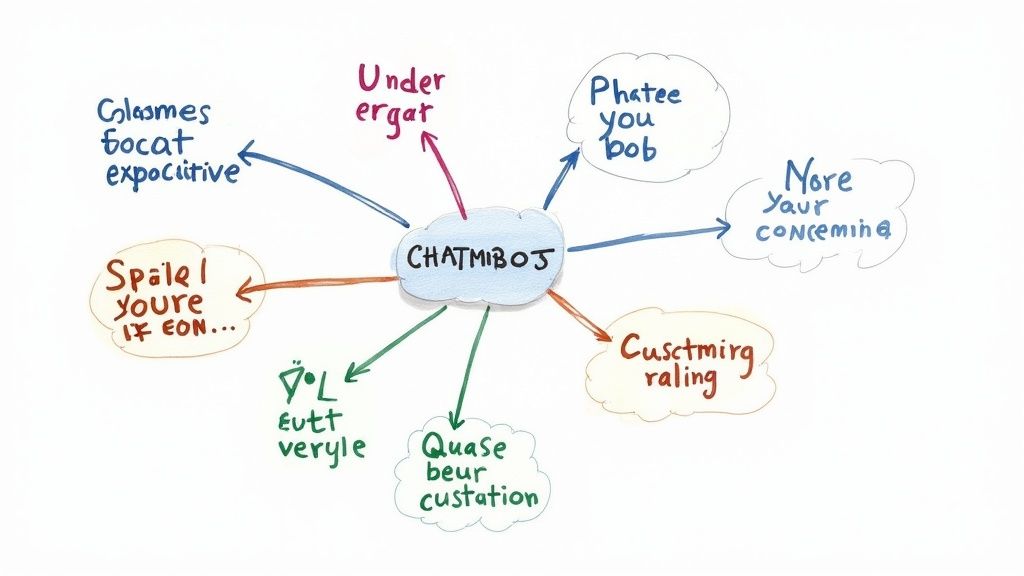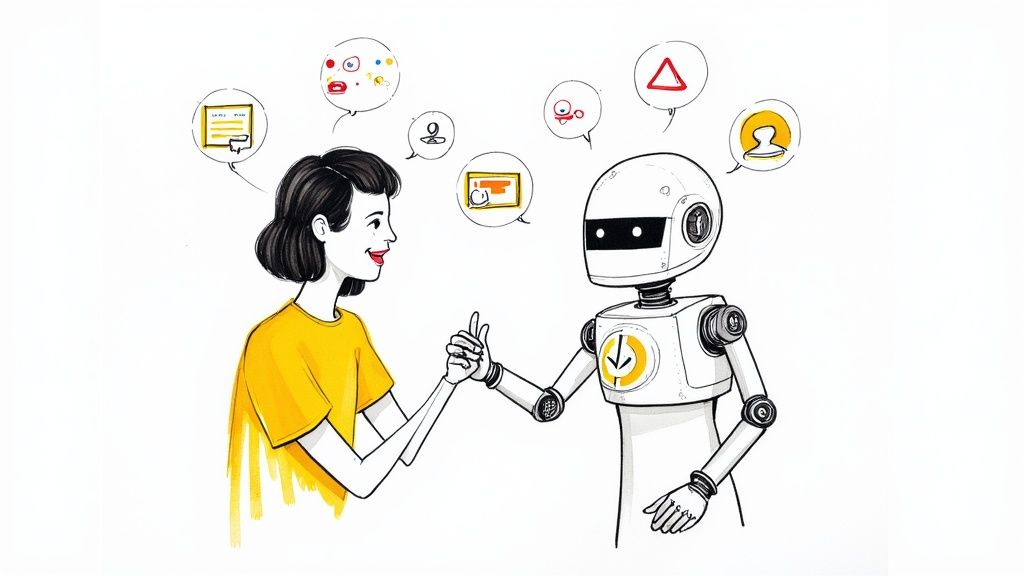Customer Service Chatbots in 2024
Why Traditional Customer Service Needs AI Innovation

Customer service teams face growing challenges as they try to meet rising customer demands. Long wait times, inconsistent support quality, and high costs are frustrating both customers and businesses. As support centers struggle with staff turnover and increasing workloads, it's clear that a fresh approach is needed - which is where AI chatbots come in.
The Breaking Point of Traditional Support
The old model of customer service is showing serious cracks. Running 24/7 call centers costs a fortune, and finding enough staff to handle busy periods remains a constant headache. When customers have to wait on hold for long stretches, especially during peak hours, satisfaction levels drop fast. Recent studies show that 90% of customers now expect immediate responses to their questions. Traditional support teams simply can't keep up with this need for instant help. On top of that, maintaining consistent service quality across large teams of agents presents an ongoing challenge.
How AI Chatbots Fill the Gaps
AI chatbots offer practical solutions to these common support problems. They can work around the clock without breaks, giving customers instant help at any hour. This means businesses can handle high volumes of requests without long queues, even during the busiest times. Tools like Sitebot can learn from huge amounts of support data to accurately answer a wide range of customer questions. This frees up human agents to focus on the complex issues where their empathy and problem-solving skills matter most. Learn more about putting AI to work in our guide to revolutionizing customer service by creating your own GPT chatbot.
Transforming Support with AI: Real-World Examples
We're already seeing impressive results from companies using AI chatbots effectively. Unity, for example, added an AI agent to their support team and saw a big drop in support tickets, saving significant money and time. Other businesses are finding similar success by using AI to speed up their support and improve customer experiences. These real examples show that AI support isn't just an interesting idea - it's delivering clear benefits right now.
Addressing Implementation Fears and Ensuring Success
Some companies hesitate to try AI, worried about complex setups and high costs. But modern platforms like Sitebot make it simple to add AI chatbots to your support mix. The key is starting with a clear plan and specific goals in mind. By choosing the right tools and focusing on concrete use cases, businesses can boost their efficiency while keeping service quality high. Taking these smart steps helps companies build stronger customer relationships while controlling costs.
Building a Business Case for AI Support

Making a strong case for AI customer service requires looking past flashy technology promises and focusing on real business impact. The key is understanding exactly how AI chatbots can improve operations and deliver measurable returns. Before investing, companies need clear answers about cost savings, efficiency gains, and improvements to customer experience.
Quantifying the Value of AI Chatbots
AI chatbots drive value primarily through increased efficiency and lower operating costs. By automating routine customer interactions, businesses can significantly reduce staffing needs, especially during busy periods that traditionally require extra support staff. The numbers speak for themselves - companies using AI chatbots typically resolve customer issues 52% faster than traditional methods. This speed boost means better customer satisfaction and allows human agents to tackle more nuanced problems requiring emotional intelligence and complex problem-solving. For example, when a support team gets swamped with basic questions about account access or password resets, an AI chatbot can handle these standard requests automatically while agents focus on helping customers with unique situations needing a personal touch.
Measuring Success: Key Metrics for AI Support
To truly understand if AI support is working, you need to track specific performance indicators. Simply having the technology isn't enough - careful measurement shows what's successful and what needs adjustment.
| Metric | Description |
|---|---|
| Average Handling Time (AHT) | Measures the average duration of each customer interaction. AI should aim to reduce this. |
| First Response Time (FRT) | How quickly customers receive an initial response. AI excels at minimizing this. |
| Resolution Rate | The percentage of issues resolved through AI interaction. |
| Customer Satisfaction (CSAT) | Measures how satisfied customers are with the AI support experience. |
| Cost per Contact | The overall cost associated with each customer interaction. AI can significantly lower this. |
These metrics paint a complete picture of AI's impact on your customer support. Tools like Sitebot make it simple to monitor these key numbers through built-in analytics dashboards. Regular tracking helps prove the real business value to stakeholders while giving you the insights needed to fine-tune your AI system as your company grows and customer needs change.
Designing AI Interactions That Feel Human

While measuring success metrics is essential for AI customer support, creating genuine connections with customers makes the real difference. The goal is to build interactions that feel natural and caring, not just automate responses. When customers feel heard and understood, they're more likely to stay loyal to your brand.
Balancing Efficiency with Empathy
The best customer service combines quick solutions with genuine care. You can achieve this by carefully planning how your AI chatbot communicates. Simple phrases like "I understand this is frustrating" show customers you recognize their feelings. Using casual, friendly language instead of stiff corporate speak helps create real connections - just like a skilled support agent would do.
Crafting Authentic AI Responses
Think about how you'd handle a delayed order. Instead of just stating the new delivery date, you could say "I'm sorry about the delay. I know waiting longer than expected is frustrating. To make it right, we'd like to offer you 10% off your next purchase." This kind of response addresses both the practical and emotional sides of the issue. Tools like Sitebot let you customize your chatbot's personality to match your company's style and values.
Handling Complex Emotions and Seamless Transitions
Sometimes customers are upset and need extra care. While AI handles many basic questions well, there are times when human help works better. Your chatbot can spot signs of frustration or anger and smoothly pass the conversation to a person. A simple "I want to make sure you get the best help possible. Let me connect you with one of our customer service experts" makes the switch feel natural and shows you value the customer's needs.
Examples of Effective Conversation Flows
Good chatbot conversations work by understanding what customers need and responding appropriately. If someone asks about a product, the chatbot might say "What would you like to know about it?" before sharing specific details. This keeps things focused and helpful. Or if someone's browsing help articles, the chatbot could offer "Need help finding something specific?" These small touches make interactions feel more personal. With 90% of customers now expecting quick responses, well-designed AI chat support helps meet those needs while maintaining quality service. By focusing on natural conversation and knowing when to bring in human help, AI chatbots can improve customer support and help grow your business.
Implementation Strategies That Actually Work

Getting a customer service chatbot to work well takes careful planning and ongoing effort. Beyond just picking a platform, you need to think about how you'll train the AI, connect it with your current tools, and help your team adapt to working alongside it. Let's look at the key steps to make this happen.
Training Your AI Chatbot for Success
For your chatbot to give helpful answers, it needs good training data. Start by feeding it your FAQ pages, product guides, and past customer conversations so it learns how to handle common questions. Tools like Sitebot make it easy to shape your chatbot's personality and responses to match your brand's voice. When you take time to customize these elements, customers get a more natural and consistent experience.
Seamless Integration with Existing Systems
Your chatbot needs to work smoothly with your current customer service tools. By connecting it to your CRM system, the chatbot can see important details like order history and past conversations. This means when someone asks about their recent order, the chatbot can quickly look up the information and give an update without passing them to a human agent. This saves time and makes things easier for your customers.
Preparing Your Team for AI Collaboration
As you bring in an AI chatbot, your support team needs to understand how to work with it effectively. Make it clear which tasks the chatbot will handle and which ones need a human touch. While the AI can take care of basic questions, your team should be ready to step in for situations that need empathy or complex problem-solving. This lets everyone focus on what they do best, making your customer support more effective overall. Want to learn more? Check out: How to master website success with AI chatbots.
Step-by-Step Implementation Guide and Timelines
Starting with a small test run is often the best way to introduce a customer service chatbot. This lets you see how well it performs and make improvements before rolling it out to everyone.
| Phase | Timeline | Activities |
|---|---|---|
| Planning | 2-4 weeks | Define objectives, identify key metrics, choose a platform, and plan integration. |
| Development | 4-8 weeks | Train the AI, customize responses, and test the chatbot's performance. |
| Pilot Program | 2-4 weeks | Deploy the chatbot to a small group of customers and gather feedback. |
| Full Rollout | 4-8 weeks | Launch the chatbot to all customers and monitor performance closely. |
| Ongoing Optimization | Continuous | Analyze data, refine AI training, and adjust strategies based on customer interactions. |
Following these steps helps ensure a smooth launch and shows the real value of your customer service chatbot. By adapting this approach to fit your specific needs, you can use AI to improve your customer support and help your business grow.
Building Trust Through Transparent AI
Creating an effective customer service chatbot requires earning and keeping customer trust. When customers understand how the AI works and feel their needs are being properly handled, they're more likely to embrace and even prefer chatbot interactions. The key is finding the right balance between automated assistance and maintaining a human connection throughout the experience.
Open Communication: Setting Clear Expectations
The first step in building trust is being direct about who - or what - customers are talking to. Starting conversations by identifying the chatbot as an AI assistant prevents confusion and helps set appropriate expectations. For example, a simple message like "Hi, I'm a Sitebot AI assistant here to help you today" lets customers know exactly what kind of interaction to expect. It's equally important to be upfront about what the AI can and cannot do. When a request goes beyond the chatbot's abilities, customers should be smoothly connected to a human agent, with clear communication about the handoff process.
Respecting Privacy: Data Handling and Security
As concerns about personal data grow, being clear about information collection and usage becomes essential. Customers need straightforward explanations of what data the chatbot collects, how that data gets used, and the security measures protecting it. This means having easy-to-find privacy policies and providing clear reasons when asking for sensitive details. Following data regulations like GDPR and maintaining strong security helps show customers their information is in good hands. When people understand their data is being handled carefully, they're more willing to trust AI systems.
Demonstrating Value: Showcasing AI's Benefits
Alongside addressing concerns, it helps to highlight the practical benefits chatbots provide. Quick responses, 24/7 availability, and efficient issue resolution make a real difference in customer experience. Sharing concrete examples, like response time improvements or successful resolution rates, helps customers see the tangible value of AI support. This is especially relevant since 90% of customers now want immediate answers - something chatbots are uniquely equipped to provide.
Continuous Improvement: Feedback and Iteration
Building trust requires ongoing effort and willingness to adapt based on customer input. Actively asking for feedback about chatbot interactions provides valuable insights for making the system better. This feedback helps improve the AI's responses and understanding while showing customers their experience matters. Sitebot includes features that make it easy to gather feedback and refine the chatbot over time. By demonstrating commitment to improvement, businesses show they take customer service quality seriously.
Scaling Success: Future-Proofing Your AI Strategy
Customer service chatbots have become an essential part of modern business operations. As AI technology continues to advance, businesses need clear strategies to stay competitive and meet customer needs. The key is building flexible AI systems that can grow and adapt alongside your business.
Adapting to the Evolving Needs of Customers
Today's customers want fast, personalized support that feels natural and helpful. After experiencing smooth interactions with AI in their daily lives, people have higher expectations for customer service. For example, waiting on hold or getting generic responses feels especially frustrating when they know better AI solutions exist. To meet these rising standards, businesses need chatbots that can understand context, remember previous conversations, and adapt their communication style to each customer. The focus should be on creating AI that learns from every interaction to provide better, more personalized service.
Keeping Pace with New Technology
New AI capabilities emerge almost daily, bringing fresh opportunities to improve customer service. The challenge lies in identifying which advances actually matter for your business goals. Natural language processing is getting better at understanding complex conversations and picking up on emotional cues. For instance, modern chatbots can detect when a customer is frustrated and adjust their tone accordingly. They can also grasp subtle context clues to provide more relevant answers. Want to measure your chatbot's effectiveness? Check out our guide on How to master chatbot analytics.
Building for Long-Term Success
Creating a lasting AI strategy requires more than chasing the newest features. You need a solid foundation that can grow with your business without requiring constant rebuilds. This means choosing flexible platforms like Sitebot that make it easy to add new capabilities as they become available. Think of it like building with blocks - you want to be able to add new pieces without taking apart the whole structure. This approach helps you stay current while protecting your initial investment.
Making the Most of Sitebot
Sitebot gives you the tools to build effective, adaptable customer service chatbots. With an easy-to-use interface, powerful GPT-4 integration, and detailed analytics, you can create chatbots that truly help your customers while supporting your business goals. The platform makes it simple to improve customer satisfaction, handle support requests more efficiently, and grow your business.
Ready to improve your customer service with AI? Start your free trial with Sitebot today!


